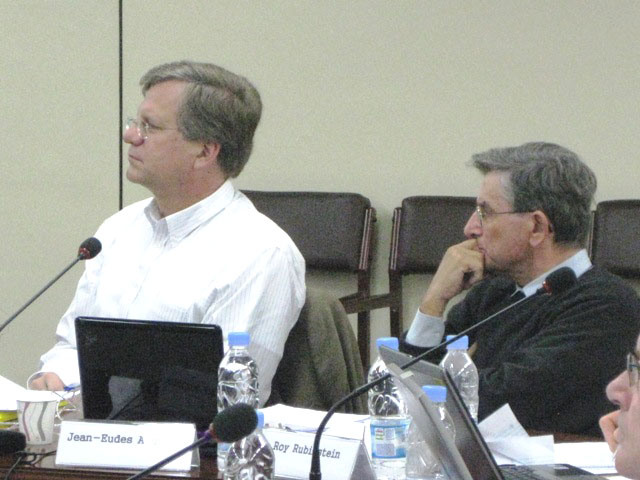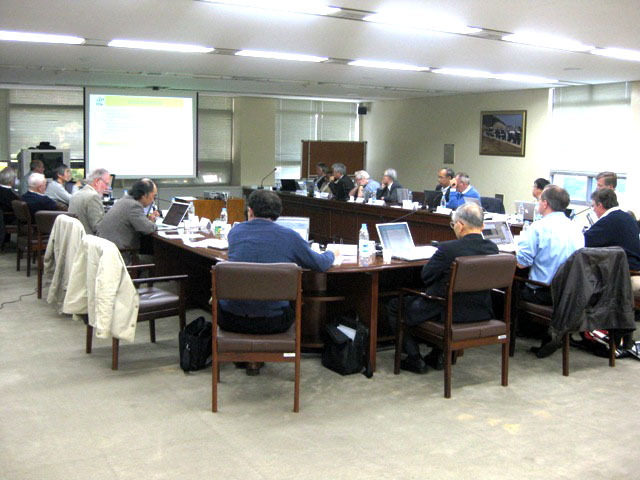Director's Corner
10 December 2009
 Barry Barish |
The ILC Project Advisory Committee considers proposed ILC baseline revisions
Much of our work this year has been focussed on assessing the ILC Reference Design Report (RDR) produced in 2007, in order to determine what changes to the RDR baseline to make for the technical design effort that will be carried out over the next three years. The motivation to make changes is to use a better optimised baseline, with a special emphasis on cost savings. In recent months the project managers have presented a "strawman" baseline (SB2009) to the broader ILC community at a workshop in Albuquerque and to the International Linear Collider Steering Committee's Project Advisory Committee (ILCSC PAC) at a review in Pohang, Korea last November. We have now received the report of the PAC review and I discuss some highlights of that review here.
 Jon Bagger, chair of ILCSC, and Jean-Eudes Augustin, chair of the PAC Jon Bagger, chair of ILCSC, and Jean-Eudes Augustin, chair of the PAC |
 The PAC review underway at the Pohang Accelerator Laboratory at POSTECH The PAC review underway at the Pohang Accelerator Laboratory at POSTECH |
The three ILC project managers have led the SB2009 effort, working closely with the technical task managers to help evaluate their selective set of proposed changes. They organised the presentation to the PAC, which was based on the proposed baseline changes presented to the community at Albuquerque. The discussions at the Albuquerque meeting resulted in better definitions of the ongoing work to assess the potential changes, as well as a set of physics performance questions relative to the present baseline. I will discuss the performance questions and responses in a future column.
The PAC review team at Pohang were Jean-Eudes Augustin (Chair), Jon Bagger (ILCSC Chair-ex officio), Lyn Evans, Günther Geschonke, Akira Masaike, Robert Orr, Raj Pillay, Roy Rubinstein (Secretary), Masakazu Yoshioka, and two committee members were missing: Don Hartill, (who attended partly by phone) and Steve Holmes. The accelerator SB2009 part of the review was carried out the first day, and the detector/physics, including the results of the Letter of Intent (LOI) process, were reviewed the second day.
The overall conclusions of the PAC were that they were pleased with the progress on re-baselining and they agreed that the containment of the accelerator costs is very valuable. Our plan is to contain cost growth in the technical design partially by making savings in the re-baselining that will help compensate cost growth in other areas. The PAC emphasised that good communications with the detector community is essential, and also the recent working group set up on this subject is very useful. I will address physics and detector impacts of the proposed new baseline in a future column.
A key outcome of the review is a set of questions that the PAC has address to us for answers over the coming months. The questions from the PAC are the following:
- 1. Why are the cost savings only ~ 3% in going from 2 tunnels to 1? Do such seemingly small savings justify the increased reliability risks inherent in a single tunnel scheme? Also, why are the cost savings only ~ 3% in going from ~ 6 Km damping rings to ~ 3 Km ones?
2. How feasible are each of the two rf distribution systems proposed for the single tunnel option?
3. What is the effect on the electron beam emittance of having the positron source at the end of the electron linac? What is the effect of this positron source location on the experiments when they run at cm energies below ~ 250 GeV?
4. How is the lack of significant R&D on the undulator positron source affecting confidence in this source design?
5. How practical is the traveling focus concept, and what studies give confidence in its use in the ILC?
6. Are there any concerns about the apparent complexity of the proposed tunnel layout in the BDS/DR/IR region?
7. How much can one rely on the program evaluating the machine availability?
Some of these questions involve technical issues, some conceptual issues and some strategic issues, and we will be considering all of them and responding to them as we document the proposed baseline changes. The next big step for us will be to present the new baseline proposal to our internal Accelerator Advisory Panel in early January. The process should result in an official new baseline in March at our next large ILC workshop in Beijing.
As an aside, the meeting room at the Pohang Accelerator laboratory brings back some vivid memories for several of us. It turns out to be the same room where the International Technical Review Panel (ITRP) spent many long hours at its final meeting deliberating on the difficult choice between "warm" and "cold" technology for the ILC. The PAC meeting was far less dramatic, but nevertheless, this meeting represents another incremental step toward producing a solid design and basis for an ILC construction project.
-- Barry Barish